Microsoft AI-900 Dumps - The Sure Way To Pass Exam
AI-900 Exam Questions (Updated 2022) 100% Real Question Answers
Certification Path
There is no pre-requisite certififcation to sit for this exam. This is a Microsoft Fundamental Certfifcation and will give you Microsoft Certified: Azure AI Fundamentals certification title.
NEW QUESTION 12
For each of the following statements, select Yes if the statement is true. Otherwise, select No.
NOTE: Each correct selection is worth one point.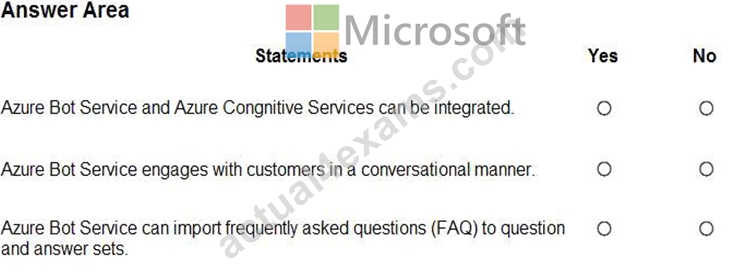
Answer:
Explanation: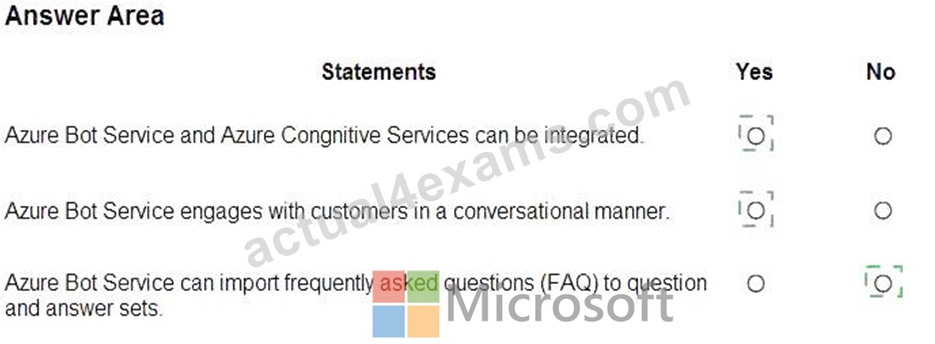
Explanation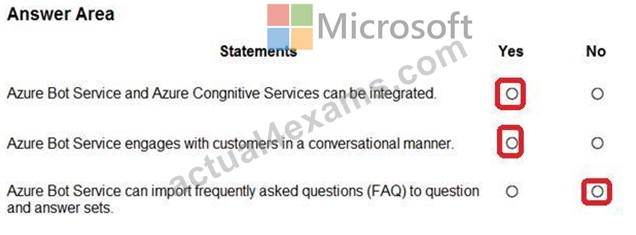
Box 1: Yes
Azure bot service can be integrated with the powerful AI capabilities with Azure Cognitive Services.
Box 2: Yes
Azure bot service engages with customers in a conversational manner.
Box 3: No
The QnA Maker service creates knowledge base, not question and answers sets.
Note: You can use the QnA Maker service and a knowledge base to add question-and-answer support to your bot. When you create your knowledge base, you seed it with questions and answers.
Reference:
https://docs.microsoft.com/en-us/azure/bot-service/bot-builder-tutorial-add-qna
NEW QUESTION 13
Match the types of computer vision to the appropriate scenarios.
To answer, drag the appropriate workload type from the column on the left to its scenario on the right. Each workload type may be used once, more than once, or not at all.
NOTE: Each correct selection is worth one point.
Answer:
Explanation:
Explanation:
Box 1: Facial recognition
Face detection that perceives faces and attributes in an image; person identification that matches an individual in your private repository of up to 1 million people; perceived emotion recognition that detects a range of facial expressions like happiness, contempt, neutrality, and fear; and recognition and grouping of similar faces in images.
Box 2: OCR
Box 3: Objection detection
Object detection is similar to tagging, but the API returns the bounding box coordinates (in pixels) for each object found. For example, if an image contains a dog, cat and person, the Detect operation will list those objects together with their coordinates in the image. You can use this functionality to process the relationships between the objects in an image. It also lets you determine whether there are multiple instances of the same tag in an image.
The Detect API applies tags based on the objects or living things identified in the image. There is currently no formal relationship between the tagging taxonomy and the object detection taxonomy. At a conceptual level, the Detect API only finds objects and living things, while the Tag API can also include contextual terms like "indoor", which can't be localized with bounding boxes.
Reference:
https://azure.microsoft.com/en-us/services/cognitive-services/face/
https://docs.microsoft.com/en-us/azure/cognitive-services/computer-vision/concept-object-detection
NEW QUESTION 14
Which AI service should you use to create a bot from a frequently asked Questions (FAQ) document?
- A. QnA Maker
- B. Text Analytics
- C. Speech
- D. Language Understanding (LUIS)
Answer: A
NEW QUESTION 15
Match the Microsoft guiding principles for responsible AI to the appropriate descriptions.
To answer, drag the appropriate principle from the column on the left to its description on the right. Each principle may be used once, more than once, or not at all.
NOTE: Each correct selection is worth one point.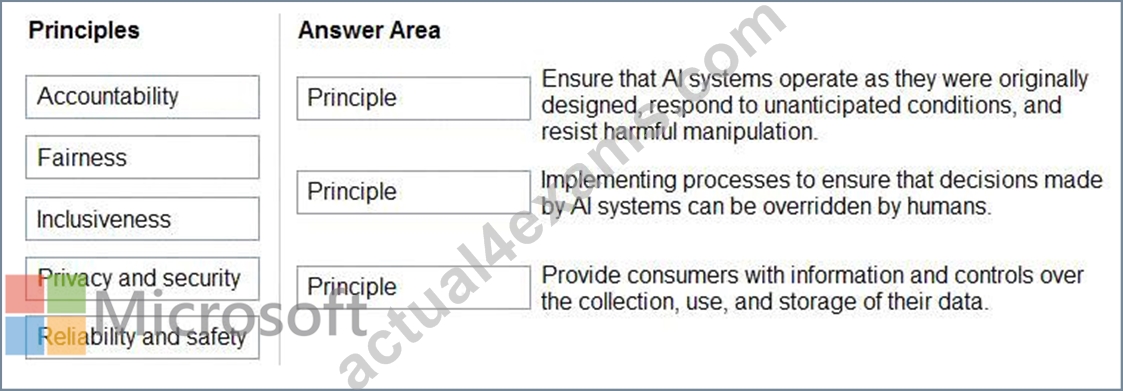
Answer:
Explanation: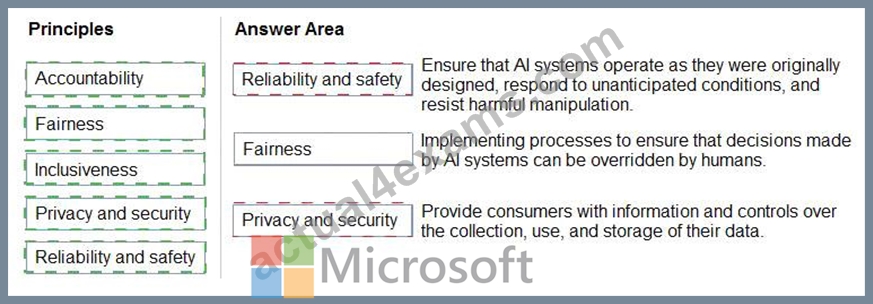
Explanation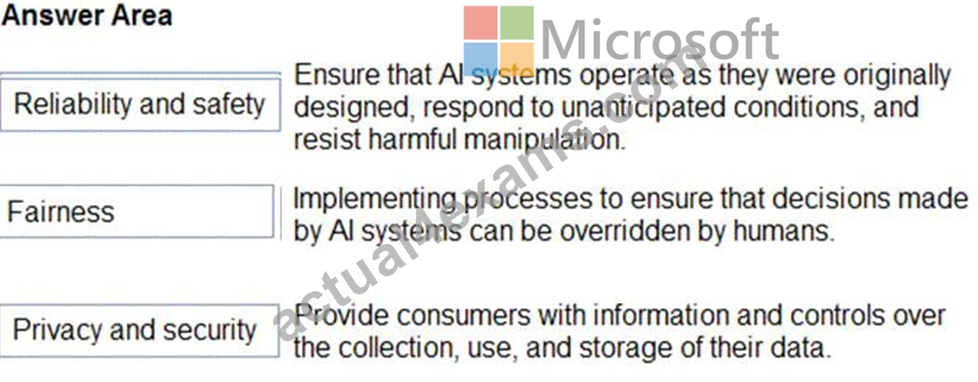
Box 1: Reliability and safety
To build trust, it's critical that AI systems operate reliably, safely, and consistently under normal circumstances and in unexpected conditions. These systems should be able to operate as they were originally designed, respond safely to unanticipated conditions, and resist harmful manipulation.
Box 2: Fairness
Fairness: AI systems should treat everyone fairly and avoid affecting similarly situated groups of people in different ways. For example, when AI systems provide guidance on medical treatment, loan applications, or employment, they should make the same recommendations to everyone with similar symptoms, financial circumstances, or professional qualifications.
We believe that mitigating bias starts with people understanding the implications and limitations of AI predictions and recommendations. Ultimately, people should supplement AI decisions with sound human judgment and be held accountable for consequential decisions that affect others.
Box 3: Privacy and security
As AI becomes more prevalent, protecting privacy and securing important personal and business information is becoming more critical and complex. With AI, privacy and data security issues require especially close attention because access to data is essential for AI systems to make accurate and informed predictions and decisions about people. AI systems must comply with privacy laws that require transparency about the collection, use, and storage of data and mandate that consumers have appropriate controls to choose how their data is used Reference:
https://docs.microsoft.com/en-us/learn/modules/responsible-ai-principles/4-guiding-principles
NEW QUESTION 16
Match the machine learning tasks to the appropriate scenarios.
To answer, drag the appropriate task from the column on the left to its scenario on the right. Each task may be used once, more than once, or not at all.
NOTE: Each correct selection is worth one point.
Answer:
Explanation:
Explanation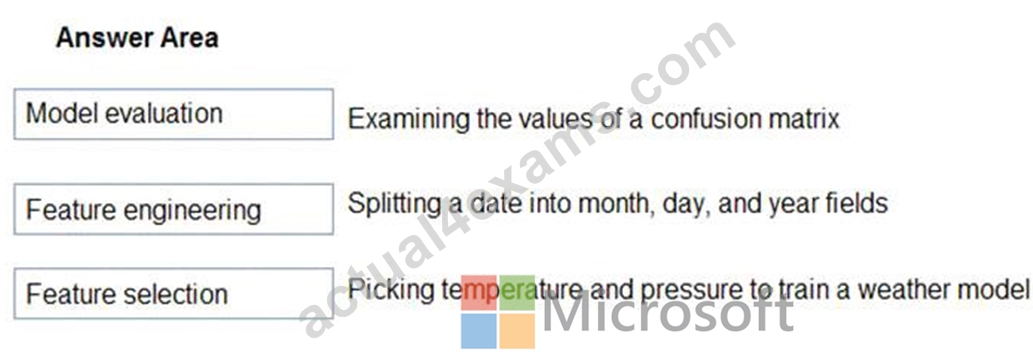
Box 1: Model evaluation
The Model evaluation module outputs a confusion matrix showing the number of true positives, false negatives, false positives, and true negatives, as well as ROC, Precision/Recall, and Lift curves.
Box 2: Feature engineering
Feature engineering is the process of using domain knowledge of the data to create features that help ML algorithms learn better. In Azure Machine Learning, scaling and normalization techniques are applied to facilitate feature engineering. Collectively, these techniques and feature engineering are referred to as featurization.
Note: Often, features are created from raw data through a process of feature engineering. For example, a time stamp in itself might not be useful for modeling until the information is transformed into units of days, months, or categories that are relevant to the problem, such as holiday versus working day.
Box 3: Feature selection
In machine learning and statistics, feature selection is the process of selecting a subset of relevant, useful features to use in building an analytical model. Feature selection helps narrow the field of data to the most valuable inputs. Narrowing the field of data helps reduce noise and improve training performance.
Reference:
https://docs.microsoft.com/en-us/azure/machine-learning/studio/evaluate-model-performance
https://docs.microsoft.com/en-us/azure/machine-learning/concept-automated-ml
NEW QUESTION 17
For each of the following statements, select Yes if the statement is true. Otherwise, select No.
NOTE: Each correct selection is worth one point.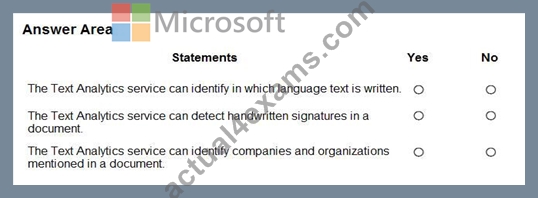
Answer:
Explanation: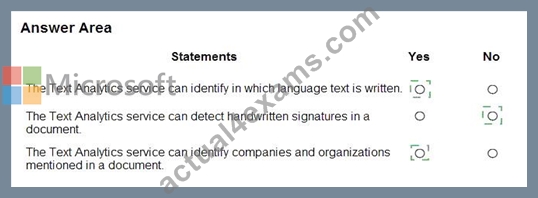
Explanation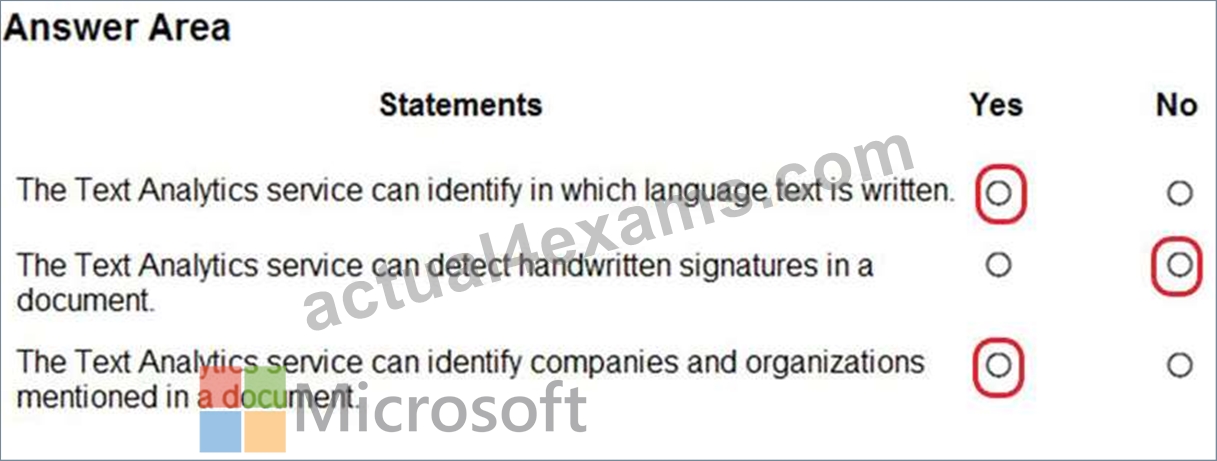
The Text Analytics API is a cloud-based service that provides advanced natural language processing over raw text, and includes four main functions: sentiment analysis, key phrase extraction, named entity recognition, and language detection.
Box 1: Yes
You can detect which language the input text is written in and report a single language code for every document submitted on the request in a wide range of languages, variants, dialects, and some regional/cultural languages. The language code is paired with a score indicating the strength of the score.
Box 2: No
Box 3: Yes
Named Entity Recognition: Identify and categorize entities in your text as people, places, organizations, date/time, quantities, percentages, currencies, and more. Well-known entities are also recognized and linked to more information on the web.
Reference:
https://docs.microsoft.com/en-us/azure/cognitive-services/text-analytics/overview
NEW QUESTION 18
To complete the sentence, select the appropriate option in the answer area.
Computer vision capabilities can be Deployed to....................
Answer:
Explanation:
seetheanswerinbelowExplanation
Explanation:
Integrate a facial recognition feature into an app.
NEW QUESTION 19
For each of the following statements, select Yes if the statement is true. Otherwise, select No.
NOTE: Each correct selection is worth one point.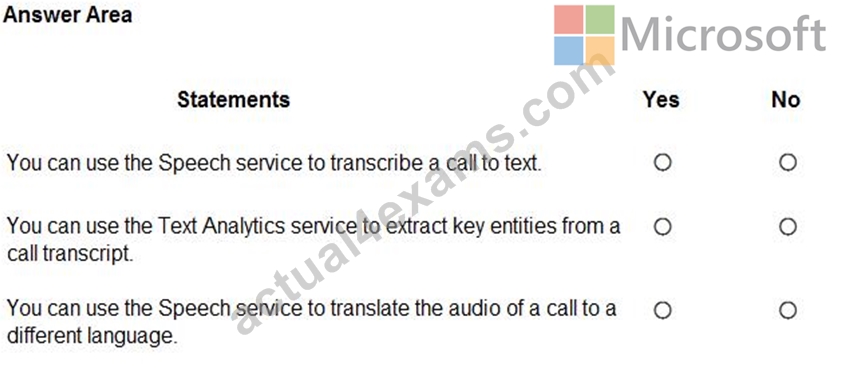
Answer:
Explanation: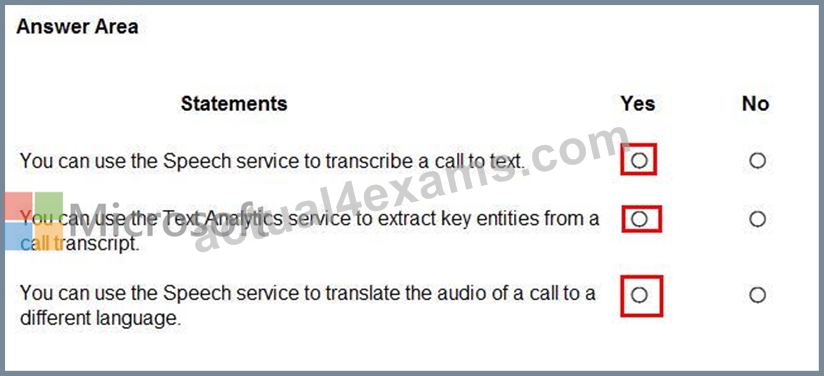
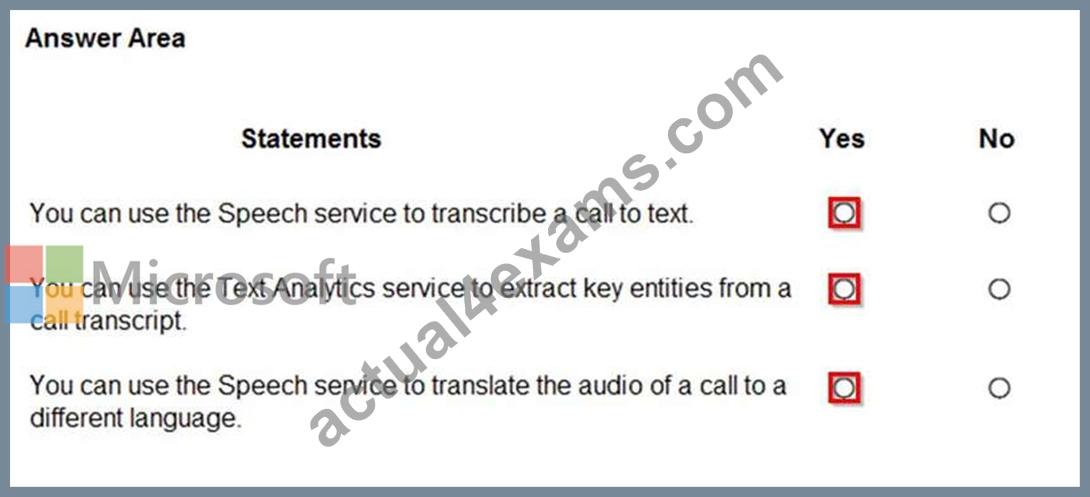
Reference:
https://docs.microsoft.com/en-gb/azure/cognitive-services/text-analytics/overview
https://azure.microsoft.com/en-gb/services/cognitive-services/speech-services/
NEW QUESTION 20
In which two scenarios can you use speech recognition? Each correct answer presents a complete solution.
NOTE: Each correct selection is worth one point.
- A. providing closed captions for recorded or live videos
- B. an in-car system that reads text messages aloud
- C. creating a transcript of a telephone call or meeting
- D. creating an automated public address system for a train station
Answer: A,C
Explanation:
Reference:
https://azure.microsoft.com/en-gb/services/cognitive-services/speech-to-text/#features
NEW QUESTION 21
To complete the sentence, select the appropriate option in the answer area.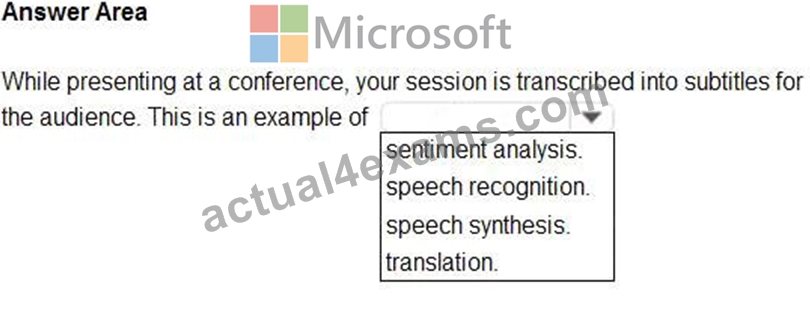
Answer:
Explanation: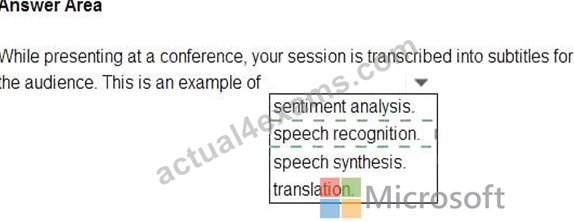
Explanation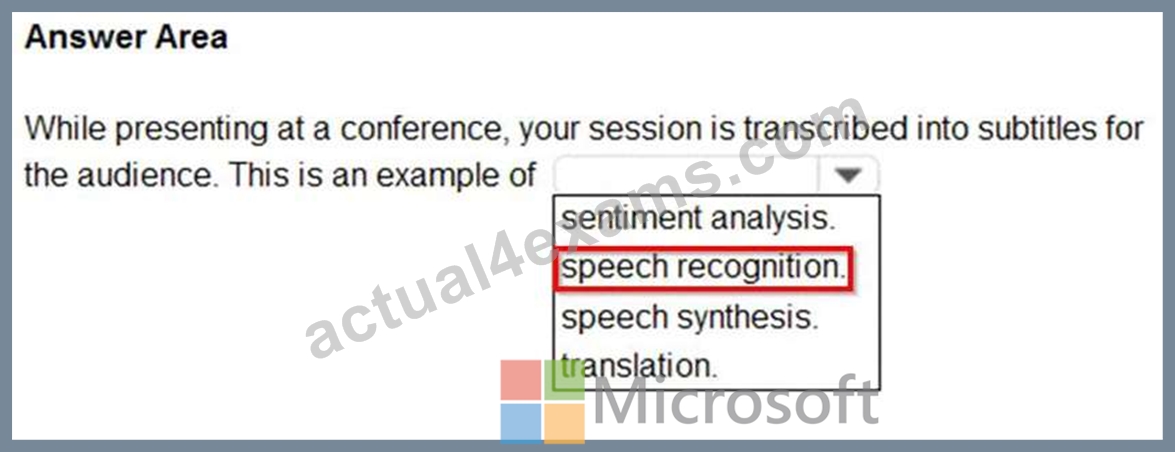
Reference:
https://azure.microsoft.com/en-gb/services/cognitive-services/speech-to-text/#features
NEW QUESTION 22
To complete the sentence, select the appropriate option in the answer area.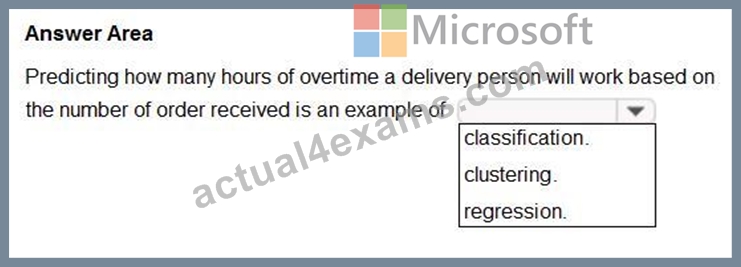
Answer:
Explanation: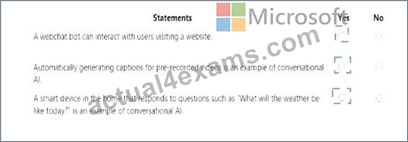
Explanation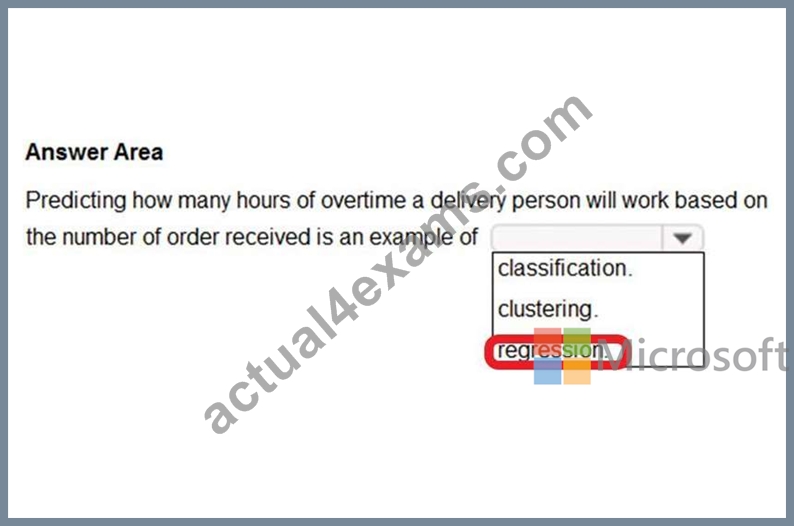
In the most basic sense, regression refers to prediction of a numeric target.
Linear regression attempts to establish a linear relationship between one or more independent variables and a numeric outcome, or dependent variable.
You use this module to define a linear regression method, and then train a model using a labeled dataset. The trained model can then be used to make predictions.
Reference:
https://docs.microsoft.com/en-us/azure/machine-learning/algorithm-module-reference/linear-regression
https://docs.microsoft.com/en-us/azure/machine-learning/studio-module-reference/machine-learning-initialize-m Regression is a form of machine learning that is used to predict a numeric label based on an item's features.
https://docs.microsoft.com/en-us/learn/modules/create-regression-model-azure-machine-learning-designer/introd
NEW QUESTION 23
You need to predict the income range of a given customer by using the following dataset.
Which two fields should you use as features? Each correct answer presents a complete solution.
NOTE: Each correct selection is worth one point.
- A. Education Level
- B. Income Range
- C. First Name
- D. Age
- E. Last Name
Answer: A,D
Explanation:
Section: Describe fundamental principles of machine learning on Azure
Explanation:
First Name, Last Name, Age and Education Level are features. Income range is a label (what you want to predict). First Name and Last Name are irrelevant in that they have no bearing on income. Age and Education level are the features you should use.
NEW QUESTION 24
Match the types of machine learning to the appropriate scenarios.
To answer, drag the appropriate machine learning type from the column on the left to its scenario on the right.
Each machine learning type may be used once, more than once, or not at all.
NOTE: Each correct selection is worth one point.
Answer:
Explanation: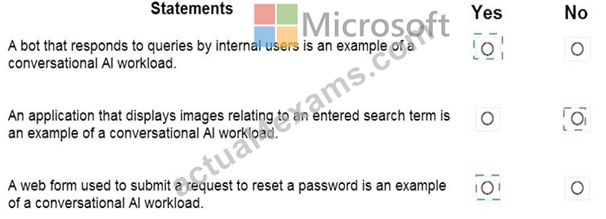
Explanation
1- Regression
2- Clustering
3- Classification
NEW QUESTION 25
Which two components can you drag onto a canvas in Azure Machine Learning designer? Each correct answer presents a complete solution.
NOTE: Each correct selection is worth one point.
- A. module
- B. compute
- C. dataset
- D. pipeline
Answer: A,C
Explanation:
Section: Describe fundamental principles of machine learning on Azure
Explanation:
You can drag-and-drop datasets and modules onto the canvas.
Reference:
https://docs.microsoft.com/en-us/azure/machine-learning/concept-designer
NEW QUESTION 26
For each of the following statements, select Yes if the statement is true. Otherwise, select No.
NOTE: Each correct selection is worth one point.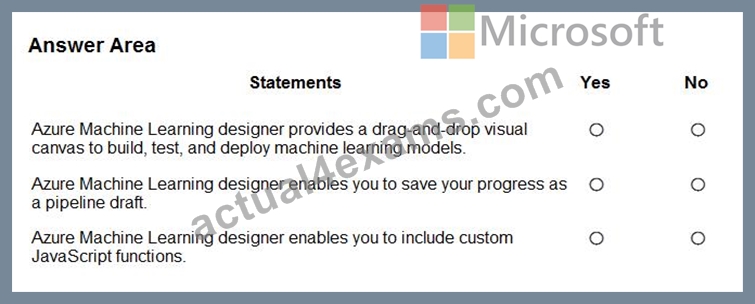
Answer:
Explanation: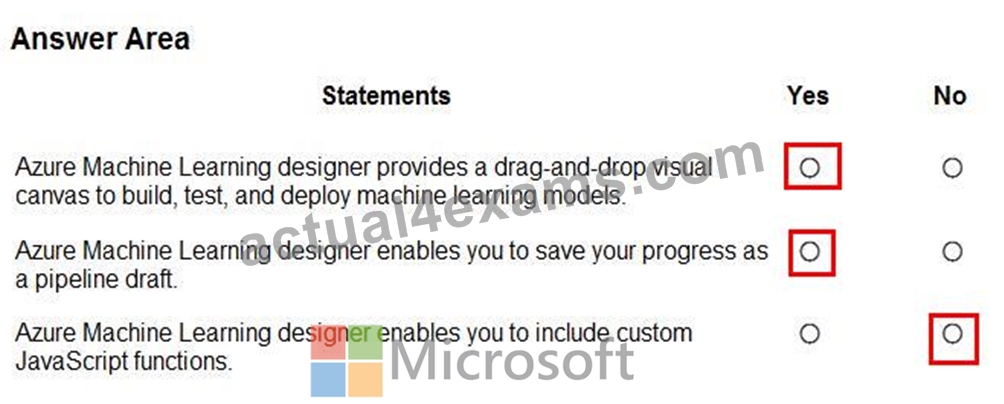
Reference:
https://docs.microsoft.com/en-us/azure/machine-learning/concept-designer
NEW QUESTION 27
Which two scenarios are examples of a conversational AI workload? Each correct answer presents a complete solution.
NOTE: Each correct selection is worth one point.
- A. a service that creates frequently asked questions (FAQ) documents by crawling public websites
- B. telephone voice menus to reduce the load on human resources
- C. a chatbot that provides users with the ability to find answers on a website by themselves
- D. a telephone answering service that has a pre-recorder message
Answer: B,C
Explanation:
Section: Describe features of conversational AI workloads on Azure
Explanation:
B: A bot is an automated software program designed to perform a particular task. Think of it as a robot without a body.
C: Automated customer interaction is essential to a business of any size. In fact, 61% of consumers prefer to communicate via speech, and most of them prefer self-service. Because customer satisfaction is a priority for all businesses, self-service is a critical facet of any customer-facing communications strategy.
Incorrect Answers:
D: Early bots were comparatively simple, handling repetitive and voluminous tasks with relatively straightforward algorithmic logic. An example would be web crawlers used by search engines to automatically explore and catalog web content.
Reference:
https://docs.microsoft.com/en-us/azure/architecture/data-guide/big-data/ai-overview
https://docs.microsoft.com/en-us/azure/architecture/solution-ideas/articles/interactive-voice-response-bot
NEW QUESTION 28
To complete the sentence, select the appropriate option in the answer area.
Computer vision capabilities can be Deployed to....................
Answer:
Explanation:
Integrate a facial recognition feature into an app.
NEW QUESTION 29
......
Studying with Revision Books
Apart from the training endorsed by the certification vendor, it’s a good idea to exhaust the study guides from Amazon. Thus, here’s what you need to know about the two must-have revision books for the Microsoft AI-900 certification exam prep:
- Microsoft AI MVP Book: Practical Guide to Microsoft AI Written by 17 AI and Azure MVPs from all around the world
This book is a collection of skills and knowledge from a team of AI and Azure specialists with countless years of experience in the field. It is written by Microsoft Azure MVPs including Leila Etaati, Anupama Natarajan, Ashraf Ghonaim, Cameron Vetter, David Rendon, etc. who used their cumulative years of experience to design a definitive study guide and a solution for all trainees preparing for AI-900 exam. The authors state it categorically that this book does not intend to cover everything there’s to know about Microsoft AI. And that it is important to combine it with other study materials to have a better chance of passing the Microsoft AI-900 exam. In a nutshell, this guide targets AI and ML developers, architects, data scientists, .net developers, and consultants who are already familiar with the foundational AI concepts. Remember it is not your best guide if you are starting from a zero, but an excellent choice if you are already familiar with most of the concepts in this field.
- Azure AI Fundamentals: Study Guide and Practice Exam for Microsoft AI-900 Exam
This guide by David Voss is based on the current test curriculum and targets trainees looking to gain foundational knowledge of the AI solutions and services on Azure. It comprises practice test questions and explanations that are consistent with Microsoft’s online learning tools. So, if you want to prepare with confidence and pass your exam easily, get your Kindle copy today from Amazon for only around $12.
Pass Microsoft AI-900 Exam Quickly With Actual4Exams: https://www.actual4exams.com/AI-900-valid-dump.html
Prepare AI-900 Question Answers - AI-900 Exam Dumps: https://drive.google.com/open?id=1QPUdILMSnOYWzW4g7vyCJ52rtbaE4K3T

